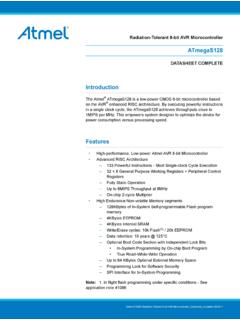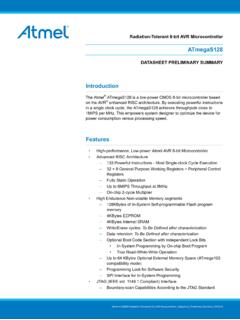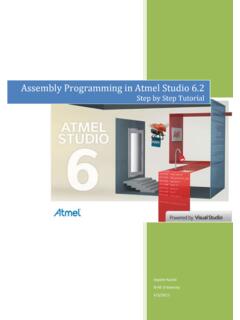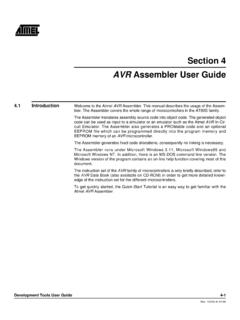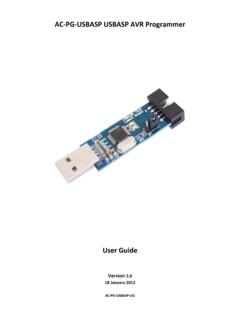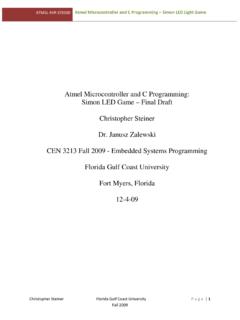Transcription of Atmel AVR042: AVR Hardware Design Considerations
1 Atmel avr042 : AVR Hardware Design Considerations Features Providing robust supply voltage, digital and analog. Connection of RESET line. SPI interface for In-System Programming. Using external crystal or ceramic resonator oscillators. 1 Introduction This application note has been written to provide answers to some of the questions and problems faced when starting designs involving Atmel AVR microcontrollers . The application note treats topics that are known to cause problems. The scope is to provide an introduction to potential Design problems rather than being an exhaustive walk-through of how to Design applications using the AVR microcontrollers . This document is thus a collection of information from existing Atmel AVR documents, combined with information that is not previously documented.
2 It is highly recommended to read the application note AVR040 - EMC Design Considerations before initiating a new Design , especially if the aim of the Design is a commercial application that needs to meet the requirements of the EMC directive (or similar directives in countries outside Europe). The application note is available from the AVR section of the official Atmel website 8-bit Atmel microcontrollers Application Note Rev. 2521K-AVR-03/11 2 avr042 2521K-AVR-03/11 2 Power Supply Two aspects should be considered when designing the power supply for the discrete/digital elements of an Atmel AVR ; ESD protection and noise emission. Both these topics are treated in details in the AVR040 application note, and only a short summary is included in this document.
3 Digital supply Looking at the datasheet for an avr microcontroller , one can be fooled to believe that power supply is not critical. The device has a very wide voltage range, and draws only a few mA supply current. But as with all digital circuits, the supply current is an average value. The current is drawn in very short spikes on the clock edges, and if I/O lines are switching, the spikes will be even higher. The current pulses on the power supply lines can be several hundred mA if all eight I/O lines of an I/O port changes value at the same time. If the I/O lines are not loaded, the pulse will only be a few ns. This kind of current spike cannot be delivered over long power supply lines; the main source is (or should be) the decoupling capacitor.
4 Figure 2-1. Incorrect decoupling Figure 2-1 shows an example of insufficient decoupling. The capacitor is placed too far away from the microcontroller, creating a large high current loop. The power and ground planes here are parts of the high current loop. As a result of this, noise is spread more easily to other devices on the board, and radiated emission from the board is increased even further. The whole ground plane will act as an antenna for the noise, instead of only the high current loop. This will be the case if the power and ground pins are connected directly to the planes (typical for hole-mounted components) and the decoupling capacitor is connected the same way.
5 The same is often seen for boards with surface-mount components if the integrated circuits are placed on one side of the board and the decoupling capacitors are placed on the other. Figure 2-2 shows a better placement of the capacitor. The lines that are part of the high current loop are not part of the power or ground planes. This is important, as the power and ground planes otherwise will spread a lot of noise. Further, the figure avr042 32521K-AVR-03/11 shows another improvement of the decoupling. A series ferrite bead is inserted to reduce the switching noise on the power plane. The series resistance of the ferrite bead must of course be low enough to ensure that there will be no significant DC voltage drop.
6 Figure 2-2. Decoupling with series inductor. Generally, the Atmel AVR devices where power and ground lines are placed close together (like the ATmega8535) will get better decoupling than devices with industry standard pin-out (like the ATmega8515), where the power and ground pins are placed in opposite corners of the DIP package. This disadvantage can be overcome by using for example a TQFP package, which allows decoupling capacitors to be placed very close to the die. For devices with multiple pairs of power and ground pins, it is essential that every pair of pins get its own decoupling capacitor. The main supply should also have a tantalum or ceramic capacitor of some F to stabilize it. Analog supply The AVR devices that have built-in ADC have a separate analog supply voltage pin, AVcc.
7 This separate voltage supply is provided to make the analog circuits less prone to the digital noise originating from the switching of the digital circuits. To be able to obtain good accuracy with the ADC the analog supply voltage must be decoupled separately, in the same manner as the digital supply voltage. AREF must also be decoupled, a typical value for the capacitor is 100nF. If a separate analog ground (AGND) is present, the analog ground should be separated from the digital ground, - so that the analog and digital grounds are only connected at one point, - the origin of the GND at the power supply GND. 3 Connection of RESET pin on AVRs The RESET pin on the AVR is active LOW, and setting the pin LOW externally will thus result in a reset of the AVR.
8 The RESET has two purposes: 1. To release all lines by tri-stating all pins (except XTAL pins), initialize all I/O registers and set program counter to zero. 4 avr042 2521K-AVR-03/11 2. To enter programming mode (for some parts also the PEN line is used to enter programming mode). Furthermore it is possible to enter high-voltage/parallel programming mode by drawing the RESET pin very high, where very high means (refer to the datasheet of the device for more information). The reset line has an internal pull-up resistor, but if the environment is noisy it can be insufficient and reset can therefore occur sporadically. Refer to datasheet for value of pull-up resistor on specific devices. Connecting the RESET so that it is possible to enter both high-voltage programming and ordinary low level reset can be achieved by applying a pull-up resistor to the RESET line.
9 This pull-up resistor makes sure that reset does not go low unintended. The pull-up resistor can in theory be of any size, but if the Atmel AVR should be programmed from STK500/AVRISP the pull-up should not be so strong that the programmer cannot activate RESET by draw the RESET line low. The recommended pull-up resistor is or larger when using STK500 for programming. For debugWIRE to function properly, the pull-up must not be smaller than 10k . To protect the RESET line further from noise, it is an advantage to connect a capacitor from the RESET pin to ground. This is not directly required since the AVR internally have a low-pass filter to eliminate spikes and noise that could cause reset. Applying an extra capacitor is thus an additional protection.
10 However, note that this capacitor cannot be present if debugWIRE or PDI is used. If not using High Voltage Programming it is recommended to add an ESD protecting diode from RESET to Vcc, since this is not internally provided due to High Voltage Programming. Alternatively, or in addition, a zener diode can be used to limit the RESET voltage relative to GND. The zener diode is highly recommended in noisy environments. The components should be located physically close to the RESET pin of the AVR. Figure 3-1 shows the recommended circuit on the RESET line. External RESET switch If an external switch is connected to the RESET pin it is important to add a series resistance. Whenever the switch is pressed it will short the capacitor, the current through the switch can have high peak values.
